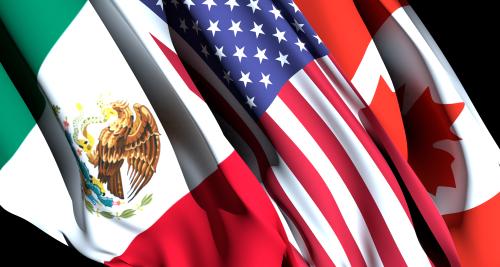The nature of the bilateral relationship between the United States and Mexico has important implications for both the local and international geopolitical landscapes. With global attention turned toward the shifting relationship, competent diplomacy and productive trade relations between the two world powers are more pertinent than ever.
On May 25, Brookings hosted a half-day symposium in U.S.-Mexico relations to discuss the future of trade and security between the neighboring nations.
Introductory Remarks:
Gerónimo Gutiérrez, Ambassador of Mexico to the United States
In his introductory remarks, recently appointed Ambassador Gutiérrez poses three key challenges to navigating the U.S.–Mexico relationship going forward.
- Is there a fundamental change in the relationship as a result of the Trump administration?
- Is there room to revisit and renegotiate NAFTA in a way that benefits all three parties involved?
- Is it possible for the United States and Mexico to continue productive security and law enforcement cooperation if the political climate of the bilateral relationship has deteriorated?
Panel 1: U.S.–Mexico relations – Ambassadors’ Perspectives
Arturo Sarukhan, Former Ambassador of Mexico to the United States
Ambassador Earl Anthony “Tony” Wayne, Former Ambassador of the United States to Mexico
Moderator: Martin S. Indyk, Executive Vice President, The Brookings Institution
Ambassador Tony Wayne rejects the Trump administration’s NAFTA narrative, which blames the trade agreement for millions of American jobs lost. Instead, he highlights new technologies and automation, in addition to trade (primarily with China) as the chief deleterious actors on the American job market. Wayne advocates for an improved NAFTA agreement, a better safety net and training for those at risk of seeing their jobs automated or outsourced. Ambassador Arturo Sarukhan builds on this idea, discussing the need for domestic mechanisms to create safety networks for displaced labor. Sarukhan ultimately poses a great challenge to the United States: fixing a shattered immigration system while providing a “circular mobility of labor,” which will allow the United States to continue to grow. Immigrants themselves are not the problem.
Martin Indyk questions whether or not Trump’s constant chiding regarding rule of law in Mexico may have had a positive impact. In response, Sarukhan offers an insider’s view of the Mexican body politic, sharing that the real driver for burgeoning government accountability and anti-corruption legislation is pressure from domestic civil society and NGOs.
Panel 2: U.S.–Mexico trade and economics
Dany Bahar, Fellow, Global Economy and Development, The Brookings Institution
Gary Hufbauer, Reginald Jones Senior Fellow, Peterson Institute for International Economics
Antonio Ortiz Mena, Senior Advisor, Albright Stonebridge Group
Moderator: Mireya Solis, Senior Fellow, Foreign Policy, The Brookings Institution
Dany Bahar offers a straightforward approach to understanding the deficit in bilateral trade. Consumers believe that when spending money (importing) is inherently bad for the economy, but when earning money (exporting) is good, but the United States and Mexico have different export baskets and are not truly competitors in that sense. If the United States were to curb trade with Mexico, each would still wind up in a trade deficit with someone else.
Beyond the oft-discussed NAFTA, Gary Hufbauer introduces two other negotiations that he believes carry equal weight and will have a more rapid impact. First is Trump’s direct talks with CEOs of major companies. The second are unilateral trade actions, which Hufbauer discusses extensively in his report. Under this action, President Trump could employ an (almost) unlimited ability to effectively halt trade with anyone. The president has already begun to play this card, and though Mexico has so far been spared this action, Hufbauer implores Mexico not to “hold their breath.” He also sees little hope for a NAFTA negotiation coming to fruition this year.
Despite his initial wariness of the deal, Antonio Ortiz Mena now holds an optimistic outlook for NAFTA. For NAFTA to become more successful and acceptable, he offers three types of upgrades: internal, external, and the architecture of the agreement itself.
Panel 3: U.S.–Mexico security and border issues
Vanda Felbab-Brown, Foreign Policy, The Brookings Institution
Doris Meissner, Senior Fellow and Director, U.S. Immigration Policy Program
Audrey Singer, Senior Fellow, Urban Institute
Vanda Felbab-Brown offers an expert overview of the drug related violence that has precipitated more border crossings from Mexico to the United States. The “high-value targeting” rather than a ground-up approach in Mexico contributes to the disorganization of the Mexican drug cartel system, which has led to a power struggle, and new, more violent drug gangs. According to Felbab-Brown, Trump’s proposed wall would do little to curb drug flows from Mexico to the United States, nor would it promote security.
Doris Meissner offers two key policy takeaways for U.S.-Mexico security and immigration relations. The United States must now invest in bolstering the immigration court system and the asylum adjudication system to offer quick and just decisions. This would help the United States uphold humanitarian protections as well as prevent immigrants from coming into the United States under the auspices of being placed on a backlog and having several years before their case is heard.
In 2000, out of 1.6 million illegal immigrants apprehended at the southern U.S. border, 98 percent were Mexican. In 2016, only 400,000 illegal immigrants were apprehended at the southern U.S. border, over half of whom were from Central America. On the macro level, the United States and Mexico need to jointly address the situation in Central America, lest that dire situation continue to flow upstream to Mexico and the United States.
Audrey Singer takes the longer view on Mexican migration to the United Sates, discussing a comprehensive history of Mexican immigration to the United States. She describes a shrinking pool of Mexican migrants to the United States due to phenomena such as a drop in birth rate and greater economic opportunities in the United States. When U.S. economic growth slowed during the recession, so did migration from Mexico; however the perception that the border was “out of control” remained.
The U.S.-Mexico relationship is at a critical point. Severing ties would have devastating outcomes on both sides of the Rio Grande. At this moment, the two nations must work together to ensure economic progress and the security of its citizens, institutions and organizations.



Commentary
Renegotiating the U.S.-Mexico relationship in 2017
June 1, 2017